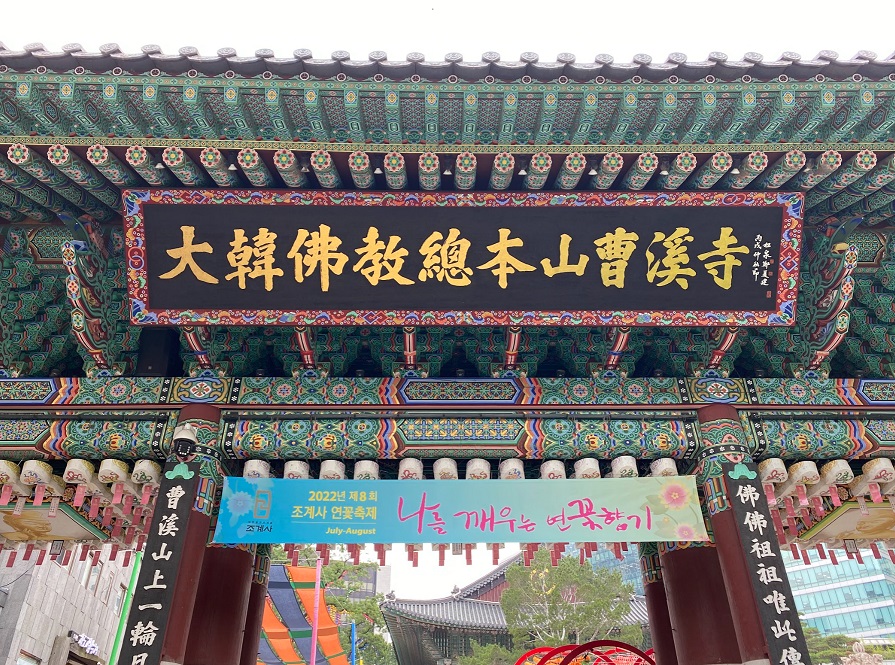Continuing from last week’s post, down the street from 경복궁 is a Buddhist temple called 조계사 (Jogyesa). Built in 1395, this temple has led the Jogye Order of Korean Buddhism, also known as comprehensive Buddhism, for over 600 years! The Jogye order is an integration of Korean Zen and Textual Schools of Buddhism whose guiding principle is to become enlightened by looking directly into the nature of the mind and using this knowledge to guide all beings to salvation. The main practices include Zen meditation, reading sutras, chanting, and mantra recitation. 조계사 was founded as a site of solidarity for the promotion and independence of Buddhist thought and practice. Today, the temple also serves as a center for education, culture, and social services.
In a similar way to 경복궁, 조계사 lies within the heart of Seoul, a structure of traditional architecture immersed among modern skyscrapers. When you walk through the main temple arch, the inscription above is actually written in Chinese, since the Chinese language was considered the language of the highly educated and cultured citizens while the Korean writing system, 한글 (han geul), was considered the language of the common people. Just past the arch, there is a little stream filled with bright orange and white koi fish. According to Buddhist tradition, koi fish represent good fortune, perseverance, and courage. Around the koi fish pond hang hundreds of little paper lotus flowers which are also important in Buddhism as the lotus symbolizes purity, spiritual awakening, and faithfulness.

Inside the main temple are three massive golden statues of the Buddha. When they first came into view, this was a big woah moment for me. I don’t know if they are hollow or build of solid gold but I’ve never seen statues like this before. In a similar way to the Holy Trinity in Christianity, Buddhism has the Buddha Triad as one god in three forms: the Shakyamuni Buddha in the center who founded Buddhism, the Medicine Buddha to the left who helps all who are suffering physically and emotionally, and the Amitbha Buddha on the right who established the Western Paradise where beings can be reborn into enlightenment. While I was at 조계사, a monk was leading the people in mantra recitations and chants. I’ve learned a little about Buddhism in a World Religions class I took in high school, but it was really cool and beautiful to see this practice in person.

Although roughly half of the South Korean population identifies as non religious (56%), the other half is split between Buddhism (16%) and Christianity (28%) and as a practicing Catholic myself, I wanted to find a mass to go to every Sunday while in Korea. Down the street from Yonsei University is a Catholic church called 천주교회 (Cheon ju gyo hui) which has become my little church community for these six weeks. I actually had a hard time finding it my first Sunday because there’s a narrow driveway that’s easy to miss leading up a hill and finally to the church, but we made it on time! The church community is entirely made up of older Korean adults, so with my tall stature, blonde hair, and blue eyes, I definitely stuck out as the only foreigner and I felt a little out of place at first. But they are so kind. My first day, when I walked in looking lost and confused, a lady showed me where to get a packet with the responses and where to find a seat. And during the sign of peace they all acknowledge each other, and me, with a bow and the phrase 축복합니다, which literally translates to “bless you.”

At 천주교회, there are a few parts that are different from Catholic masses I’ve been to in the United States. For one, there is a sort of mass narrator who says when to sit and stand and leads everyone in a couple of prayers before mass officially begins and after mass ends. Additionally, at the beginning of mass, everyone is given an envelope where you put your donations and then during the collection, everyone stands and processes to the altar where there is a basket to collect all the donations. They also don’t hold hands for the Our Father prayer, but that could also be because of Covid.
Overall though, the mass is beautiful. Even though the church is built in a simple style with few decorations and only a couple stained glass windows above the altar, the choir sings beautifully to a piano and sometimes even a cello and it feels good to be a part of such a wonderfully accepting community.
